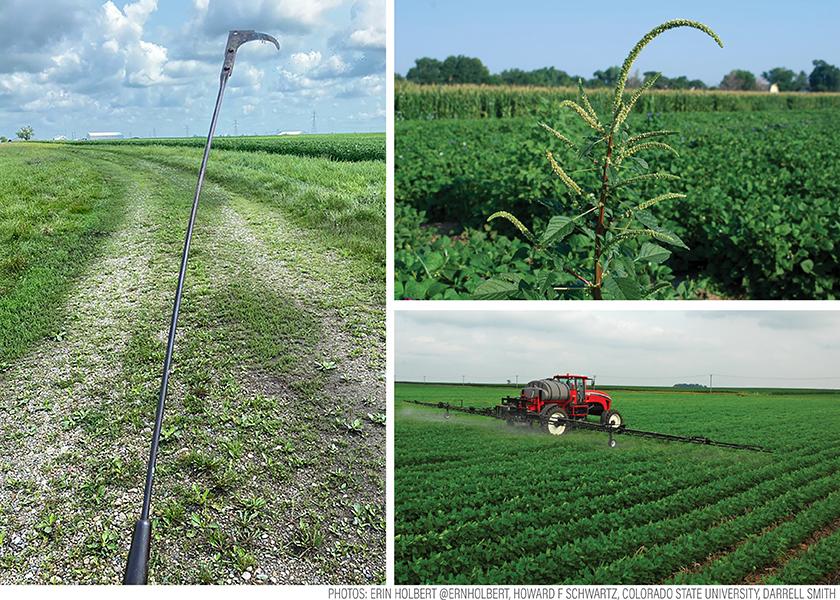Show Weeds Who's Boss: Use Multiple Tactics

Use multiple tactics to take out tough broadleaves and grasses
For weed control in soybeans you need a back-up plan to your back-up plan this season, says Jared Greuel, founder of Greuel Farm Services.
That means you might have to pull the cultivator out of your shed this spring and walk some fields to hand-pull weeds this summer, in addition to applying herbicides.
“There are too many foundational products that just aren’t available for whatever reason, especially for grasses,” Greuel says. “People are going to have to expand their comfort zone to figure out what they can use. Whether we like it or not, or want to do it or not, it’s just the situation we face.”
USE LIMITED HERBICIDE SUPPLIES JUDICIOUSLY
Farmers need to consider how to best use limited supplies of glyphosate and glufosinate to their greatest benefit, Greuel says.
“Because once you use it, it’s gone and you have no way of knowing this summer if you’re going to be able to re-place it or not,” he adds, referencing glyphosate specifically. “Liberty (glufosinate) is very difficult to get a hold of, too, so consider if there is any other product you can use in its place.”
For growers with a limited amount of glyphosate or glufosinate, consider using them in soybeans, as there generally are more options for burndown and postemergence herbicide options in corn, says Bill Johnson, Purdue University weed scientist.
Spring tillage, he adds, is an option to replace herbicide burndown treatments but offers two cautions. Use spring tillage only if the weeds are small, as larger weeds tend to survive tillage and are then that much more difficult to control with post herbicides. In addition, beware of wet fields as tillage will contribute to compaction problems.
BUILD A SEASON-LONG PROGRAM
Early season weed competition is a big contributor to unseen yield losses in soybeans, notes Luke Schulte, field agronomist for Beck’s Hybrids.
That potential loss makes the use of burndown and pre-emergence herbicides more important than ever, so you should plant into a clean field and give the crop a strong start.
Schulte says waiting to control weeds with a postemerge herbicide application can cost at least 2.5% of soybean yield for every growth stage when control measures are delayed.
Research by Clarence Swanton, professor emeritus at the University of Guelph, shows yield loss in soybeans can start even before the crop emerges, depending on the presence and amount of other vegetation present, Schulte says.
In addition, Swanton shows yield loss in soybeans (and corn, too) is irreversible, regardless of whether a long growing season remains.
That’s counter to popular thought in years past, when some farmers and other members of the ag industry believed soybean yields could rebound from weed pressure’s impact.
CONSIDER DRIVER WEEDS
What weeds most impact your yields and long-term weed management plans? Larry Steckel, University of Tennessee Extension weed scientist, encourages farmers to determine these “driver weeds” on a field-by-field basis as they plan their control strategy this season.
Herbicide-resistant Palmer amaranth (pigweed) and waterhemp are two key weeds for farmers in the mid-South and the Midwest, per the Weed Science Society of America (WSSA).
Even with farmers’ increased use of premix herbicides that contain multiple active ingredients, both weeds are tough to control. Use this guidance from WSSA:
- Herbicide-resistant Palmer amaranth withstands applications from up to nine different herbicide modes of action in Groups 2, 3, 4, 5, 9, 10, 14, 15 and 27.
- Herbicide-resistant waterhemp is now resistant to eight different modes of action in Groups 2, 3, 4, 5, 9, 14, 15 and 27.
“There is no replacement for Liberty (glufosinate) in fields where dicamba/2,4-D-resistant amaranth is present,” Steckel adds.
Steckel is telling soybean growers to borrow a practice from cotton and rice growers — rely on overlapping residual herbicides. The concept is simple: Layer residual herbicides in fields so control is ongoing and doesn’t run out.
The common practice is to apply residual herbicides before soybean emergence. Then follow up with a second residual herbicide in combination with a postemergence herbicide before weeds reach 4" tall within 30 days of soybean emergence.

EVALUATE YOUR PRACTICES TO IMPROVE RESULTS
As always, read product labels, Greuel says. You want to make sure whatever you apply is going to control your problem weeds, and you want to use the product in accordance with the label recommendations.
Anything you can do from a management standpoint is worth the investment, Greuel adds.
“There’s also what one of my college professors called Satan’s exercise for weed control – walking beans,” he says. “Whether or not we want to walk beans is another question, but it is an option.”
Rhonda Brooks leverages 35 years of experience and farm roots to report on seeds and agronomy and serves as editor of Bovine Veterinarian.







